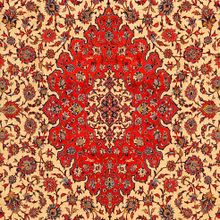Difference between revisions of "Isfahan Rug"
| Line 37: | Line 37: | ||
Isfahan rugs originate from Isfahan, located between two mountain ranges just south of Tehran, Isfahan is the capital city of the province. The weaving of Isfahan rugs dates back to the 16th century. During its peak in the 17th century Isfahan became the capital of Iran. The most sought after Isfahan rugs are made by the very famous master weaver, Serafian. These rugs are in such great demand that a whole industry of counterfeit Serafian traditional rugs now exists. Buyer beware. The best protection is to purchase Isfahan rugs only from a reputable dealer who will provide a certificate of authentication. The skilled artisans of authentic Isfahan rugs ply their trade using Persian knots with varying KPSI (knots per square inch), depending on the quality of the rug. | Isfahan rugs originate from Isfahan, located between two mountain ranges just south of Tehran, Isfahan is the capital city of the province. The weaving of Isfahan rugs dates back to the 16th century. During its peak in the 17th century Isfahan became the capital of Iran. The most sought after Isfahan rugs are made by the very famous master weaver, Serafian. These rugs are in such great demand that a whole industry of counterfeit Serafian traditional rugs now exists. Buyer beware. The best protection is to purchase Isfahan rugs only from a reputable dealer who will provide a certificate of authentication. The skilled artisans of authentic Isfahan rugs ply their trade using Persian knots with varying KPSI (knots per square inch), depending on the quality of the rug. | ||
<!-- from Rugman Archive:https://web.archive.org/web/20080220223446/http://www.rugman.com:80/Content/isfahan.html --> | <!-- from Rugman Archive:https://web.archive.org/web/20080220223446/http://www.rugman.com:80/Content/isfahan.html --> | ||
| + | == History == | ||
| + | == Materials == | ||
| + | === Foundation and Pile === | ||
| + | == Techniques and structures == | ||
| + | === Color and dyeing === | ||
| + | === Motifs and Designs === | ||
| + | === Weaving techniques === | ||
| + | == See also == | ||
| + | == References == | ||
| + | {{Reflist}} | ||
| + | == Bibliography == | ||
| + | Abraham Levi Moheban, (2015), ''[[The Encyclopedia of Antique Carpets|The Encyclopedia of Antique Carpets: Twenty-Five Centuries of Weaving]]'', NewYork: Princeton Architectural Press. | ||
[[Category:Persian Rug and Carpet]] | [[Category:Persian Rug and Carpet]] | ||
[[Category:Rug and Carpet]] | [[Category:Rug and Carpet]] | ||
[[fa:قالی_اصفهان]] | [[fa:قالی_اصفهان]] | ||
Revision as of 13:54, 24 December 2019
| Isfahan Rug | |
|---|---|
 Design of Isfahan Rug (Rugman) | |
| General information | |
| Name | Isfahan Rug |
| Original name | قالی اصفهان |
| Alternative name(s) | Isfahan Carpet |
| Origin | |
| Category | City |
| Technical information | |
| Common designs | Lachak Toranj, Tree, Arabesque (Eslimi) |
| Common colors | Crimson, Cream, Navy Blue, Ruby, Begie, Blue |
| Dyeing method | Natural, Synthetic |
| Pile material | Silk |
| Foundation material | Silk, Cotton |
| Knot type | Asymmetrical (Persian), Jufti |
Isfahan rugs originate from Isfahan, located between two mountain ranges just south of Tehran, Isfahan is the capital city of the province. The weaving of Isfahan rugs dates back to the 16th century. During its peak in the 17th century Isfahan became the capital of Iran. The most sought after Isfahan rugs are made by the very famous master weaver, Serafian. These rugs are in such great demand that a whole industry of counterfeit Serafian traditional rugs now exists. Buyer beware. The best protection is to purchase Isfahan rugs only from a reputable dealer who will provide a certificate of authentication. The skilled artisans of authentic Isfahan rugs ply their trade using Persian knots with varying KPSI (knots per square inch), depending on the quality of the rug.
History
Materials
Foundation and Pile
Techniques and structures
Color and dyeing
Motifs and Designs
Weaving techniques
See also
References
Bibliography
Abraham Levi Moheban, (2015), The Encyclopedia of Antique Carpets: Twenty-Five Centuries of Weaving, NewYork: Princeton Architectural Press.